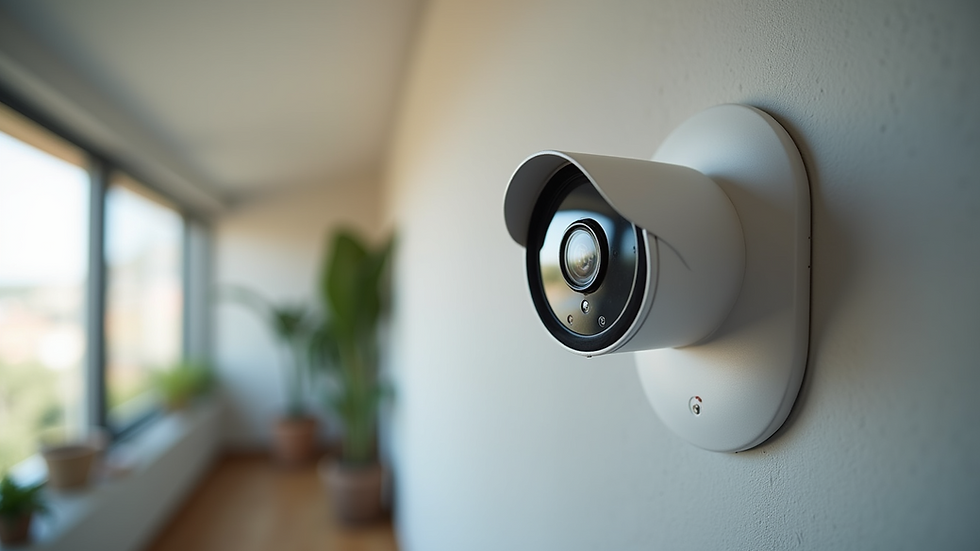Unseen Vulnerabilities: How Smart Home Devices May Open the Door to Cyber Intrusions
- David Keeton, Jr.

- Aug 15
- 3 min read
Smart home devices have quickly become an essential part of daily life, making our homes smarter and more efficient. From controlling lights with a voice command to remotely monitoring security cameras, these devices offer a wealth of convenience. However, with this convenience comes risk. Many users overlook the security flaws in these devices, which can be exploited by cybercriminals. In this post, we will dive into the vulnerabilities of smart home devices and offer practical tips to help you secure your digital home.

The Rise of Smart Home Devices
The smart home market has grown tremendously, with over 50% of households in the U.S. reported to own at least one smart device as of 2022. Products like smart thermostats, security cameras, and smart speakers are designed to work together, communicating over the internet. While this interconnectedness simplifies home management, it significantly increases the risk of cyberattacks.
Consider a scenario where a hacker gains access to your Wi-Fi network. They could manipulate your smart locks to gain physical access to your home or steal sensitive data stored on connected devices. This illustrates how a small vulnerability can lead to major consequences.
Common Vulnerabilities in Smart Home Devices
Weak Passwords
Weak and default passwords are among the most significant vulnerabilities for smart home devices. According to a recent study, over 80% of data breaches occur due to weak credentials. Many users neglect to change factory-set passwords, making it easy for cybercriminals to take control.
To prevent this, create strong, unique passwords for all your devices. A password should contain at least 12 characters and include a combination of uppercase and lowercase letters, numbers, and symbols. If remembering all your passwords is a challenge, consider using a password manager.
Insecure Network Connections
Many smart home devices connect to the internet over unsecured Wi-Fi networks. If your network does not have encryption, hackers can intercept the data sent from your devices to the internet.
To safeguard your network, make sure you use WPA3 encryption, the most secure form currently available. Regularly updating your router's firmware is also essential, as it protects against known vulnerabilities.
Outdated Software and Firmware
Manufacturers frequently issue updates to patch security holes, yet many users ignore these prompts. Cybercriminals are quick to exploit outdated software. A report found that 60% of smart home device owners had not updated their devices in the last year, leaving them vulnerable.
Enable automatic updates when possible and regularly check for manual updates to keep all devices secure.
The Role of IoT Security Standards
The Internet of Things (IoT) is growing rapidly, and so is the need for comprehensive security standards. Not all devices follow these guidelines, so it’s crucial to choose wisely. When purchasing new smart home devices, look for devices that adhere to established security standards, such as the IoT Cybersecurity Improvement Act.
Additionally, researching a manufacturer’s history regarding updates and vulnerabilities can provide insight into whether their products will keep you safe. Brands with high ratings and a commitment to customer safety can lower your risk of a cyber incident.
Best Practices for Securing Your Smart Home
Segment Your Network
Creating a separate network for your smart devices can greatly enhance security. This limits potential damage if a breach occurs. For instance, if your smart camera is compromised, a segmented network ensures that your personal devices remain safe. Most routers allow you to set up guest networks or VLANs; consult your router manual for guidance.
Use Two-Factor Authentication
Two-factor authentication (2FA) adds an essential layer of security. By requiring a second form of verification, 2FA makes it challenging for unauthorized individuals to access your devices.
Whenever available, enable 2FA on your accounts connected to smart home devices. This simple yet effective step can significantly decrease your chance of unauthorized access.
Regularly Review Device Permissions
It is important to review the permissions for each device in your smart home. Many devices require access to sensitive information or other connected systems. Regularly going through these permissions can help you revoke access to unnecessary functions, reducing the risk of data breaches. For example, if a device does not need access to your location or home network, disable that feature.

Final Thoughts
As smart home technology becomes more prevalent, understanding the security risks is crucial. While these devices bring convenience and efficiency, they also introduce vulnerabilities that can be exploited by cybercriminals. By learning about the risks and following best practices, you can secure your home from potential intrusions.
Investing time in securing your smart home devices is vital for protecting your personal data. Stay informed and take proactive steps, and you can enjoy the benefits of smart technology without compromising your safety.



